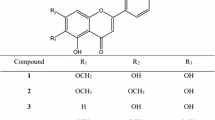Abstract
Prickly pear (Opuntia ficus-indica) is a longdomesticated crop plant of arid and semiarid parts of the world. The efficacy of extracts of prickly pear root for managing diabetes and diabetes complications was evaluated using a variety of in vitro bioassays. The ethyl acetate-soluble fraction was most effective in the prevention of diabetes and its complications via the inhibition of rat lens aldose reductase activity, the formation of advanced glycation end products, and α-glucosidase activity. MS and NMR were used to identify the bioactive compound from the ethyl acetate-soluble fraction as 3,5,7,4′-tetrahydroxyflavanone (aromadendrin).
Similar content being viewed by others
References
DeFronzo RA. Pathogenesis of type 2 diabetes: Metabolic and molecular implications for identifying diabetes genes. Diabetes Rev. 5: 177–269 (1997)
Callahan ST, Mansfield MJ. Type 2 diabetes mellitus in adolescents. Curr. Opin. Pediatr. 12: 310–315 (2000)
Wild S, Roglic G, Green A, Sicree R, King H. Global prevalence of diabetes: Estimates for the year 2000 and projections for 2030. Diabetes Care 27: 1047–1053 (2004)
Kawanishi K, Ueda H, Moriyasu M. Aldose reductase inhibitors from the nature. Curr. Med. Chem. 10: 1353–1374 (2003)
Chung SS, Chung SK. Aldose reductase in diabetic microvascular complications. Curr. Drug. Targets 6: 475–486 (2005)
Cui CB, Jeong SK, Lee YS, Lee SO, Kang IJ, Lim SS. Inhibitory activity of caffeoylquinic acids from the aerial parts of Artemisia princeps on rat lens aldose reductase and on the formation of advanced glycation end products. J. Korean Soc. Appl. Biol. Chem. 52: 655–662 (2009)
Ahmed N. Advanced glycation endproducts-role in pathology of diabetic complications Diabetes Res. Clin. Pr. 67: 3–21 (2005)
Peyroux J, Sternberg M. Advanced glycation endproducts (AGEs): Pharmacological inhibition in diabetes. Pathol. Biol. 54: 405–419 (2006)
Gillies CL, Abrams KR, Lambert PC, Cooper NJ, Sutton AJ, Hsu RT, Khunti K. Pharmacological and lifestyle interventions to prevent or delay type 2 diabetes in people with impaired glucose tolerance: Systematic review and meta-analysis. Brit. Med. J. 334: 299–302 (2007)
Butterweck V, Semlin L, Feistel B, Pischel I, Bauer K, Verspohl EJ. Comparative evaluation of two different Opuntia ficus-indica extracts for blood sugar lowering effects in rats. Phytother. Res. 25: 370–375 (2010)
Feugang JM, Konarski P, Zou D, Stintzing FC, Zou C. Nutritional and medicinal use of cactus pear (Opuntia spp.) cladodes and fruits. Front. Biosci. 11: 2574–2589 (2006)
Ibanez-Camacho R, Meckes-Lozoya M. Effect of a semipurified product obtained from Opuntia streptacantha L. (a cactus) on glycemia and triglyceridemia of rabbit. Arch. Invest. Med. 14: 437–443 (1983)
Ibanez-Camacho R, Meckes-Lozoya M, Mellado-Campos V. The hypoglucemic effect of Opuntia streptacantha studied in different animal experimental models. J. Ethnopharmacol. 7: 175–181 (1983)
Lee EH, Kim HJ, Song YS, Jin C, Lee KT, Cho J, Lee YS. Constituents of the stems and fruits of Opuntia ficus-indica var. saboten. Arch. Pharm. Res. 26: 1018–1023 (2003)
Lopez D. Review: Use of the fruits and stems of the prickly pear cactus (Opuntia spp.) into human food. Food Sci. Tech. Int. 1: 65–74 (1995)
Andrade-Cetto A, Heinrich M. Mexican plants with hypoglycaemic effect used in the treatment of diabetes. J. Ethnopharmacol. 99: 325–348 (2005)
Banos G, Perez-Torres I, El Hafidi M. Medicinal agents in the metabolic syndrome. Cardiovasc. Hematol. Agents Med. Chem. 6: 237–252 (2008)
Frati-Munari AC, de Leon C, Ariza-Andraca R, Banales-Ham MB, Lopez-Ledesma R, Lozoya X. Effect of a dehydrated extract of nopal (Opuntia ficus indica Mill.) on blood glucose. Arch. Invest. Med. 20: 211–216 (1989)
Frati-Munari AC, Fernandez-Harp JA, Banales-Ham M, Ariza-Andraca CR. Decreased blood glucose and insulin by nopal (Opuntia sp.). Arch. Invest. Med. 14: 269–274 (1983)
Trejo-Gonzalez A, Gabriel-Ortiz G, Puebla-Perez AM, Huizar-Contreras MD, Munguia-Mazariegos MR, Mejia-Arreguin S, Calva E. A purified extract from prickly pear cactus (Opuntia fuliginosa) controls experimentally induced diabetes in rats. J. Ethnopharmacol. 55: 27–33 (1996)
Shim JH, Park JT, Hong JS, Kim KW, Kim MJ, Auh JH, Kim YW, Park CS, Boos W, Kim JW, Park KH. Role of maltogenic amylase and pullulanase in maltodextrin and glycogen metabolism of Bacillus subtilis 168. J. Bacteriol. 191: 4835–4844 (2009)
Lee YS, Kang YH, Jung JY, Kang IJ, Han SN, Chung JS, Shin HK, Lim SS. Inhibitory constituents of aldose reductase in the fruiting body of Phellinus linteus. Biol. Pharm. Bull. 31: 765–768 (2008)
Prasad S, Sinha AK. Free radical activity in hypertensive type 2 diabetic patients. Int. J. Dib. Mel. 2: 141–143 (2010)
Author information
Authors and Affiliations
Corresponding author
Rights and permissions
About this article
Cite this article
Jeon, Y.E., Yin, X.F., Choi, D.B. et al. Inhibitory activity of aromadendrin from prickly pear (Opuntia ficus-indica) root on aldose reductase and the formation of advanced glycation end products. Food Sci Biotechnol 20, 1283–1288 (2011). https://doi.org/10.1007/s10068-011-0177-4
Received:
Revised:
Accepted:
Published:
Issue Date:
DOI: https://doi.org/10.1007/s10068-011-0177-4




